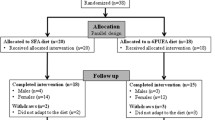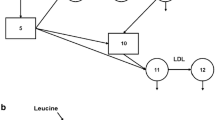Abstract
The cholesterol-suppressive actions of Palmvitee and γ-tocotrienol were assessed in hypercholesterolemic subjects after acclimation to the American Heart Association Step 1 dietary regimen for four and eight weeks, respectively. The four-week dietary regimen alone elicited a 5% decrease (P<0.05) in the cholesterol level of the 36 subjects. Subjects continuing on the dietary regimen for a second four-week period experienced an additional 2% decrease in their cholesterol levels. Dietary assessments based on unanticipated recalls of 24-h food intake records suggest that significant reductions in energy and fat, predominantly in saturated fat, intakes are responsible. The subjects experienced significant Palmvitee- and γ-tocotrienol-mediated decreases in cholesterol. The group of subjects acclimated to the dietary regimen for four weeks responded to Palmvitee (a blend of tocols providing 40 mg α-tocopherol, 48 mg α-tocotrienol, 112 mg γ-tocotrienol, and 60 mg δ-tocotrienol/day for four weeks) with a 10% decrease in cholesterol (P<0.05). Dietary assessments showed no further change in energy and fat intakes. α-Tocopherol attenuates the cholesterol-suppressive action of the tocotrienols. The second group of subjects, acclimated to the dietary regimen for eight weeks, received 200 mg-γ-tocotrienol/d for four weeks. The cholesterol-suppressive potency of this α-tocopherol-free preparation was calculated to be equivalent to that of the mixture of tocotrienols (220 mg) used in the prior study. Cholesterol levels of the 16 subjects in the second group decreased 13% (P<0.05) during the four-week trial. Plasma apolipoprotein B andex vivo generation of thromboxane B2 were similarly responsive to the tocotrienol preparations, whereas neither preparation had an impact on high density lipoprotein cholesterol and apolipoprotein A-I levels.
Similar content being viewed by others
Abbreviations
- AHA Diet:
-
American Heart Association Step 1 Diet
- ApoA-I:
-
apolipoprotein A-I
- ApoB:
-
apolipoprotein B
- HDL:
-
high density lipoprotein
- HMG-CoA:
-
3-hydroxy-3-methylglutaryl-CoA
- LDL:
-
low density lipoprotein
- TxB2 :
-
thromboxane B2
References
Parker, R.A., Pearce, B.C., Clark, R.W., Gordon, D.A., and Wright, J.J.K. (1993) Tocotrienols Regulate Cholesterol Production in Mammalian Cells by Post-Transcriptional Suppression of 3-Hydroxy-3-Methylglutaryl-Coenzyme A Reductase,J Biol. Chem. 268, 11230–11238.
Qureshi, A.A., Qureshi, N., Wright, J.J.K., Shen, Z., Kramer, G., Gapor, A., Chong, Y.H., DeWitt, G., Ong, A.S.H., Peterson, D.M., and Bradlow, B.A. (1991) Lowering of Serum Cholesterol in Hypercholesterolemic Humans by Tocotrienols (Palmvitee),Am. J. Clin. Nutr. 53, 1021S-1026S.
Tan, D.T., Khor, H.T., Low, W.H.S., Ali, A., and Gapor, A. (1991) Effect of a Palm-Oil-Vitamin E Concentrate on the Serum and Lipoprotein Lipids of Humans,Am. J. Clin. Nutr. 53, 1027S-1031S.
Wahlqvist, M.L., Krivokuca-Bogetic, Z., Lo, C.H., Hage, B., Smith, R., and Lukito, W. (1992) Differential Serum Responses to Tocopherols and Tocotrienols During Vitamin E Supplementation in Hypercholesterolaemic Individuals Without Change in Coronary Risk Factors,Nutr. Res. 12, S181-S201.
Qureshi, A.A., Nor, R.M., Gapor, A., Peterson, D.M., Pearce, B.C., and Elson, C.E., α-Tocopherol Attenuates the Impact of γ-Tocotrienol on 3-Hydroxy-3-Methylglutaryl Coenzyme A Reductase Activity,J. Nutr., in press
Qureshi, A.A., Burger, W.C., Peterson, D.M., and Elson, C.E. (1986) The Structure of an Inhibitor of Cholesterol Biosynthesis Isolated from Barley,J. Biol. Chem. 261, 10544–10550.
Anonymous (1982) Rationale of the Diet-Heart Statement of the American Heart Association. Report of the AHA Nutrition Committee (Review),Arteriosclerosis 2, 177–191.
Anonymous (1988) Report of the National Cholesterol Education Program Expert Panel on Detection, Evaluation, and Treatment of High Blood Cholesterol in Adults. The Expert Panel,Arch. Itnern. Med. 148, 36–69.
Friedwald, W.T., Levy, R.I., and Fredrickson, D.S. (1972) Estimation of the Concentration of Low Density Lipoprotein Cholesterol in Plasma Without Use of Preparative Ultracentrifuge,Clin. Chem. 18, 499–502.
Pearce, B.C., Parker, R.A., Deason, M.E., Qureshi, A.A., and Wright, J.J.K. (1992) Hypocholesterolemic Activity of Synthetic and Natural Tocotrienols,J. Med. Chem. 35, 3595–3606.
Serbinova, E., Kagan, V., Han, D., and Packer, L. (1991) Free Radical Recycling and Intramembrane Mobility in the Antioxidant Properties of alpha-Tocopherol, and alpha-Tocotrienol,Free Radic. Biol. Med. 10, 263–275.
Author information
Authors and Affiliations
About this article
Cite this article
Qureshi, A.A., Bradlow, B.A., Brace, L. et al. Response of hypercholesterolemic subjects to administration of tocotrienols. Lipids 30, 1171–1177 (1995). https://doi.org/10.1007/BF02536620
Received:
Revised:
Accepted:
Issue Date:
DOI: https://doi.org/10.1007/BF02536620




